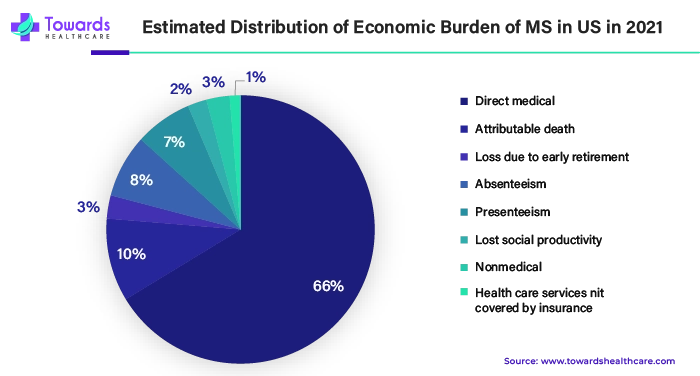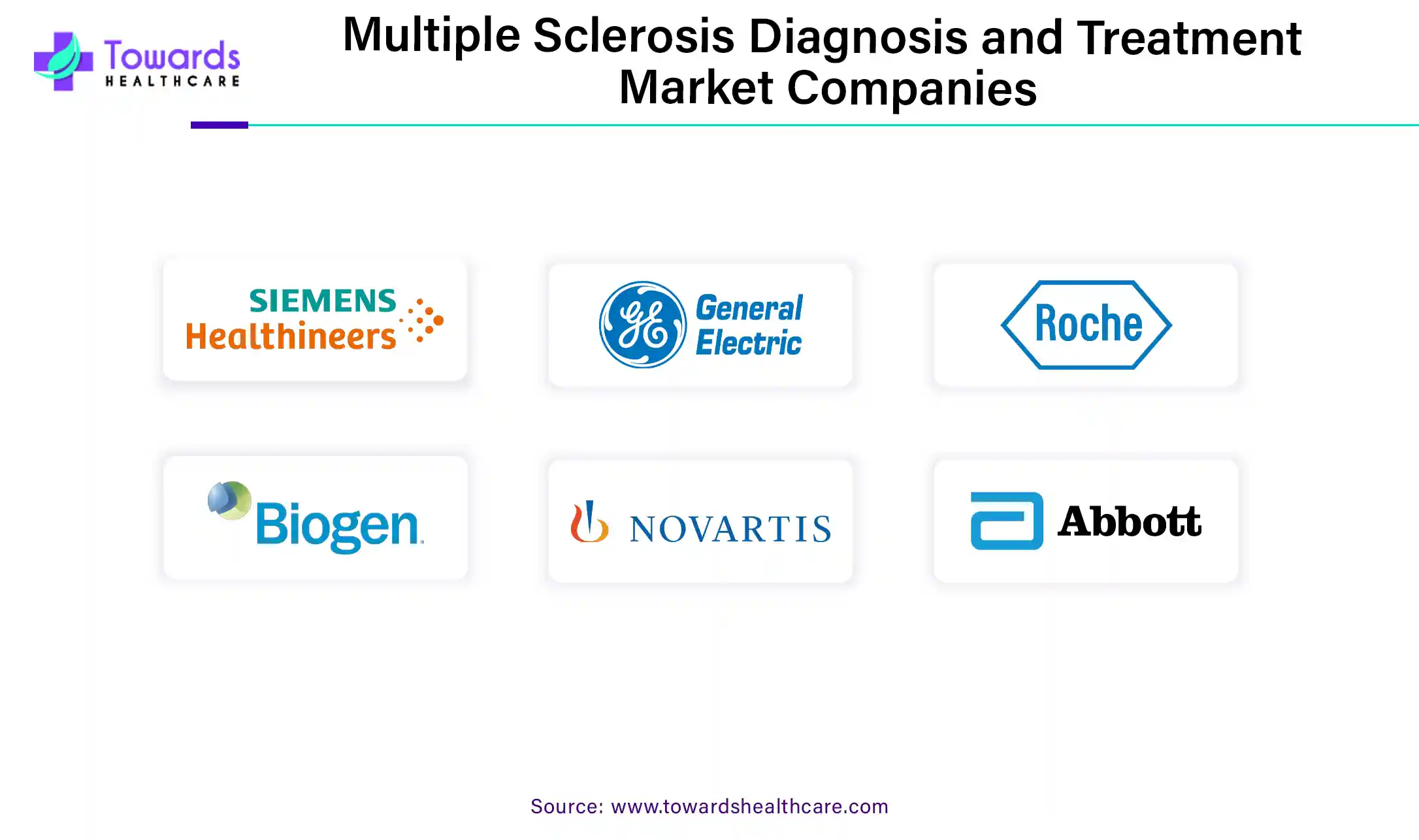December 2025

The multiple sclerosis diagnosis and treatment market size is expected to increase from USD 23.67 billion in 2025 to USD 31.98 billion by 2034, growing at a CAGR of 3.4% throughout the forecast period from 2025 to 2034.

In February 2024, Multiple Sclerosis Australia awarded 17 new research grants totaling over $4.5 million for various projects across the country. These grants support different studies and fellowships, lasting from one to five years, all aimed at essential areas of M.S. research.
Multiple sclerosis is a typical disabling neurological disease. In young adults, symptoms usually appear between 20 and 40. Multiple sclerosis develops when immune system cells, which generally defend us against bacteria, viruses, and unhealthy mis, attack central nervous system cells. Myelin is a substance that forms the protective sheath (myelin sheath) surrounding nerve fibers (axons).
Multiple sclerosis is a chronic disease that impacts individuals differently. A small percentage of people with multiple sclerosis will have a mild course with little to no disability. In contrast, others will have a slowly worsening disease that leads to increased disability over time. Most people with M.S., on the other hand, will experience brief periods of symptoms followed by extended periods of relative of relative passiveness (lack of activity or dormancy) with partial or complete recovery. The disease is rarely fatal, and most M.S. patients have average expectancy.
There are three main types of multiple sclerosis according to the progression of symptoms over time:
Increased research grants and favorable legislation are adding to the regional market's growth. For example, in November 2023, the National Multiple Sclerosis Society allocated USD 4 million towards new research initiatives, in line with their strategy outlined in the Pathways to Cure's roadmap. This investment is part of their annual commitment of over USD 30 million across more than 200 MS research projects worldwide.
For instance,
Early diagnosis techniques for multiple sclerosis have become increasingly important as they allow for timely treatment and management of the condition. Techniques such as Magnetic resonance imaging, cerebrospinal fluid analysis, and neurological help doctors detect multiple sclerosis in its early stages when symptoms are mild or absent. This early detection improves the patient's prognosis and increases the demand for treatment options. With advancements in multiple sclerosis treatment, including disease-modifying therapies and symptom management strategies, more people are seeking medical care and support upon receiving a multiple sclerosis diagnosis. This increases the demand for early diagnosis techniques to improve outcomes and enhance the quality of life for individuals living with multiple sclerosis.
Advancements in how doctors find and understand multiple sclerosis have improved greatly. They now use devices like magnetic resonance imaging, which takes super-detailed pictures of the brain and spinal cord. These pictures help doctors spot problems related to multiple sclerosis and see how the disease changes over time.
There are also new ways to test the fluid around the brain and spinal cord. These tests can find specific markers that show if someone has an M.S. or another similar problem. It's like finding specific clues that help tell multiple sclerosis apart from other brain issues. Multiple sclerosis is more common around the world. More people are diagnosed with it each year. This may be because we're better at spotting it, but because of things like changes in our environment and some genetic reasons.
Highlights of Multiple Sclerosis
When we talk about "prevalence", we mean how many people have multiple sclerosis at any given time. As more people have multiple sclerosis, there's a more significant need for good tests and treatment to help them manage the condition well. Doctors also understand how multiple sclerosis affects the body. This has led to a special treatment that can slow down the disease, make relapses less likely, and make life better for people with multiple sclerosis.
For instance,
Approximately 1.8 million individuals worldwide are believed to be affected by multiple sclerosis. As the prevalence of multiple sclerosis increases, medical professionals and researchers are intensifying their efforts to gain deeper insights into the condition and develop effective treatments. Additionally, advancements in medical technology have led to the development of new tests capable of examining cerebrospinal fluid. These tests can detect specific markers indicative of M.S. or other conditions, aiding doctors in accurately diagnosing the disease and determining the most suitable treatment approach.
With all these improvements, more treatments are now available that can help slow down multiple sclerosis and improve the lives of people who have it. Drug companies and doctors are spending a lot of money on research to find even better treatments for multiple sclerosis. Their goal is to keep improving how we care for people with multiple sclerosis as more people are affected by it.
Doctors often use imaging tests to diagnose multiple sclerosis and monitor its progression. These tests help them see what's happening inside the brain and spinal cord, where multiple sclerosis typically causes damage. Magnetic Resonance Imaging (MRI) is the imaging test used for multiple sclerosis. MRI machines use powerful magnets and radio waves to create detailed brain and spinal cord images. With an MRI, doctors can look for specific signs of multiple sclerosis, such as lesions or areas of damage in the nervous system.
Another imaging test that might be used is called optical coherence tomography. This test uses light waves to create detailed pictures of the retina, the part of the eye that sends visual information to the brain. Changes in the retina can sometimes indicate MS-related damage to the optic nerve, which connects the eye to the brain.
These imaging tests are crucial for diagnosing multiple sclerosis early and accurately. When doctors can see evidence of multiple sclerosis on a magnetic resonance imaging or optical coherence tomography scan, they can start treatment sooner, which may help slow down the progression of the disease and manage symptoms more effectively.
Because imaging tests play such a vital role in diagnosing and monitoring multiple sclerosis, there's a high demand for them in the healthcare market. This demand drives the development of new imaging technologies and techniques and the production of imaging equipment and supplies. It also influences the growth of the multiple sclerosis diagnosis and treatment market as more people seek testing and treatment options for this condition.
Treating Multiple Sclerosis can cost a lot of money, and not everyone can afford it. This means some people with multiple sclerosis might not get the treatment they need. Especially in places where there isn't much healthcare coverage, it can be challenging. Multiple sclerosis treatments include medications and therapies that help manage symptoms and slow down the progression of the disease. But these treatments can be expensive, making them out of reach for some people.
If someone can't afford multiple sclerosis treatment, it can affect their quality of life and make their symptoms worse over time. This is because, without treatment, multiple sclerosis can get worse faster, leading to more problems. In places where healthcare coverage is limited, governments and organizations might not be able to provide enough support for people with multiple sclerosis. This leaves them struggling to find affordable treatment options.
To solve this problem, there needs to be more support for people with multiple sclerosis, especially in regions where healthcare coverage is limited. This could mean making treatments more affordable or providing financial assistance to those who need it. Making multiple sclerosis treatments more accessible is essential for ensuring that everyone with multiple sclerosis can get the care they need to live better lives.
In North America, Patients can access advanced diagnostic tools like MRI scans and various treatment options. There are still challenges, especially in remote or rural areas, where healthcare facilities may need to be improved. Access to specialized care and treatments may be more difficult for people in these regions. Research and development in multiple sclerosis diagnosis and therapy are robust in North America, with academic institutions and pharmaceutical companies actively working on new therapies and diagnostic tools. While North America generally has advanced resources for multiple sclerosis diagnosis and treatment, there are still disparities in access and affordability that need to be addressed to ensure equitable care for all patients.

The landscape for multiple sclerosis diagnosis and treatment varies in the Asia-Pacific region. Some countries have well-developed healthcare systems with access to advanced diagnostic tools like MRI scans and specialized therapies. In other parts of the area, healthcare infrastructure may be limited, and access to multiple sclerosis diagnosis and treatment options may be more challenging. Countries like Japan, Australia, and Singapore have advanced healthcare facilities and expertise in multiple sclerosis management. They offer comprehensive diagnosis and treatment services, including access to disease-modifying therapies. Collaborative initiatives involving governments, healthcare providers, patient advocacy groups, and international organizations are crucial for addressing these challenges and ensuring equitable access to multiple sclerosis care across the region.
Laboratories offering diagnostic tests, such as cerebrospinal fluid analysis and genetic testing, play a significant role in multiple sclerosis diagnosis and patient management. Academic and research institutions contribute to advancements in multiple sclerosis understanding and treatment through research and development efforts. Non-profit organizations like the National Multiple Sclerosis Society (NMSS) and the Multiple Sclerosis International Federation (MSIF) advocate for multiple sclerosis awareness, research funding, and patient support services. Hospitals, clinics, and healthcare facilities provide MS diagnosis, treatment, and patient care services, often in collaboration with pharmaceutical companies and research institutions.
| Sr. No | Company Name | Product Name | Year | Global Sales in 2022 (USD Million) |
| 1. | Merck Group | Mevenclade | 2022 | 913.771 |
| 2. | Merck Group | Rabif | 2022 | 946.86 |
| 3. | Other Market Players | XX | XX | XXX.XX |

By Type
By Diagnosis
By Treatment
By Geography
December 2025
December 2025
December 2025
December 2025